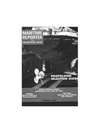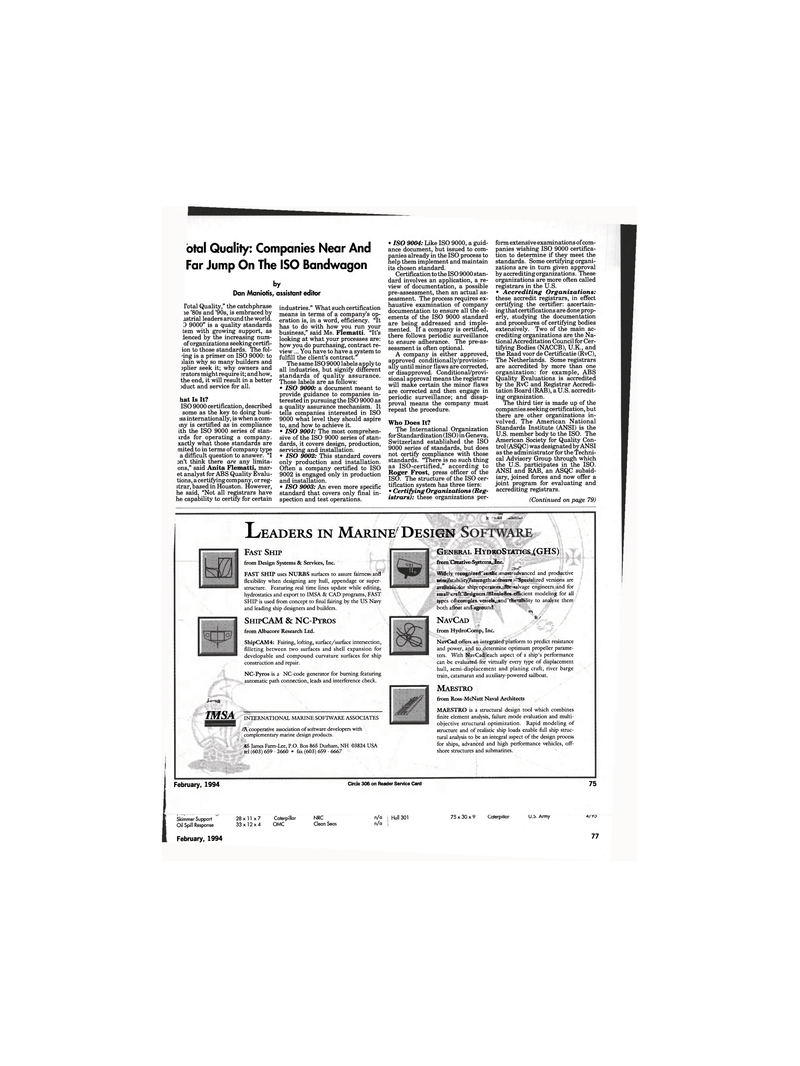
Page 65: of Maritime Reporter Magazine (February 1994)
Read this page in Pdf, Flash or Html5 edition of February 1994 Maritime Reporter Magazine
otal Quality: Companies Near And
Far Jump On The ISO Bandwagon by
Dan Maniotis, assistant editor
Total Quality," the catchphrase .le '80s and '90s, is embraced by jLstrial leaders around the world. 3 9000" is a quality standards tern with growing support, as ienced by the increasing num- of organizations seeking certifi- ion to those standards. The fol- ding is a primer on ISO 9000: to ilain why so many builders and jplier seek it; why owners and ;rators might require it; and how, the end, it will result in a better iduct and service for all. hat Is It?
ISO 9000 certification, described some as the key to doing busi- es internationally, is when a com- my is certified as in compliance ith the ISO 9000 series of stan- irds for operating a company, xactly what those standards are mited to in terms of company type a difficult question to answer. "I on't think there are any limita- ons," said Anita Flematti, mar- et analyst for ABS Quality Evalu- tions, a certifying company, or reg- strar, based in Houston. However, he said, "Not all registrars have he capability to certify for certain industries." What such certification means in terms of a company's op- eration is, in a word, efficiency. "It has to do with how you run your business," said Ms. Flematti. "It's looking at what your processes are: how you do purchasing, contract re- view ... You have to have a system to fulfill the client's contract."
The same ISO 9000 labels apply to all industries, but signify different standards of quality assurance.
Those labels are as follows: • ISO 9000: a document meant to provide guidance to companies in- terested in pursuing the ISO 9000 as a quality assurance mechanism. It tells companies interested in ISO 9000 what level they should aspire to, and how to achieve it. • ISO 9001: The most comprehen- sive of the ISO 9000 series of stan- dards, it covers design, production, servicing and installation. • ISO 9002: This standard covers only production and installation.
Often a company certified to ISO 9002 is engaged only in production and installation. • ISO 9003: An even more specific standard that covers only final in- spection and test operations. • ISO 9004: Like ISO 9000, a guid- ance document, but issued to com- panies already in the ISO process to help them implement and maintain its chosen standard.
Certification to the ISO 9000 stan- dard involves an application, a re- view of documentation, a possible pre-assessment, then an actual as- sessment. The process requires ex- haustive examination of company documentation to ensure all the el- ements of the ISO 9000 standard are being addressed and imple- mented. If a company is certified, there follows periodic surveillance to ensure adherance. The pre-as- sessment is often optional.
A company is either approved, approved conditionally/provision- ally until minor flaws are corrected, or disapproved. Conditional/provi- sional approval means the registrar will make certain the minor flaws are corrected and then engage in periodic surveillance; and disap- proval means the company must repeat the procedure.
Who Does It?
The International Organization for Standardization (ISO) in Geneva,
Switzerland established the ISO 9000 series of standards, but does not certify compliance with those standards. "There is no such thing as ISO-certified," according to
Roger Frost, press officer of the
ISO. The structure of the ISO cer- tification system has three tiers: • Certifying Organizations (Reg- istrars): these organizations per- form extensive examinations of com- panies wishing ISO 9000 certifica- tion to determine if they meet the standards. Some certifying organi- zations are in turn given approval by accrediting organizations. These organizations are more often called registrars in the U.S. • Accrediting Organizations: these accredit registrars, in effect certifying the certifier: ascertain- ing that certifications are done prop- erly, studying the documentation and procedures of certifying bodies extensively. Two of the main ac- crediting organizations are the Na- tional Accreditation Council for Cer- tifying Bodies (NACCB), U.K., and the Raad voor de Certificatie (RvC),
The Netherlands. Some registrars are accredited by more than one organization: for example, ABS
Quality Evaluations is accredited by the RvC and Registrar Accredi- tation Board (RAB), a U.S. accredit- ing organization.
The third tier is made up of the companies seeking certification, but there are other organizations in- volved. The American National
Standards Institute (ANSI) is the
U.S. member body to the ISO. The
American Society for Quality Con- trol (ASQC) was designated by ANSI as the administrator for the Techni- cal Advisory Group through which the U.S. participates in the ISO.
ANSI and RAB, an ASQC subsid- iary, joined forces and now offer a joint program for evaluating and accrediting registrars. (Continued on page 79)
JMtfj
IMSA lf: 1 i
LEADERS IN MARINE DESIGN
GENERAL HYDROSTATICS (GHS) FAST SHIP from Design Systems & Services, Inc.
FAST SHIP uses NURBS surfaces to assure fairness and flexibility when designing any hull, appendage or super- structure. Featuring real time lines update while editing, hydrostatics and export to IMSA & CAD programs, FAST
SHIP is used from concept to final fairing by the US Navy and leading ship designers and builders.
SHIPCAM & NC-PYROS from Albacore Research Ltd.
ShipCAM4: Fairing, lofting, surface/surface intersection, filleting between two surfaces and shell expansion for developable and compound curvature surfaces for ship construction and repair.
NC-Pyros is a NC-code generator for burning featuring automatic path connection, leads and interference check.
INTERNATIONAL MARINE SOFTWARE ASSOCIATES : A cooperative association of software developers with complementary marine design products. 45 James Farm-Lee, P.O. Box 865 Durham, NH 03824 USA tel (603) 659 - 2660 • fax (603) 659 - 6667 awf from Creative Systems, Inc.
Widely recognized as the most advanced and productive trim/stability/strength software. Specialized versions are available for ship operators, for salvage engineers and for small craft designers. Includes efficient modeling for all types of complex vessels, and the ability to analyze them both afloat and aground. •i 'fit' NAVCAD s ' ......:.... .. ..": from HydroComp, Inc.
NavCad: offers an integrated platform to predict resistance and power, and to determine optimum propeller parame- ters. With NavCad each aspect of a ship's performance can be evaluated for virtually every type of displacement hull, semi-displacement and planing craft, river barge train, catamaran and auxiliary-powered sailboat.
MAESTRO from Ross-McNatt Naval Architects
MAESTRO is a structural design tool which combines finite element analysis, failure mode evaluation and multi- objective structural optimization. Rapid modeling of structure and of realistic ship loads enable full ship struc- tural analysis to be an integral aspect of the design process for ships, advanced and high performance vehicles, off- shore structures and submarines.
February, 1994 Circle 306 on Reader Service Card 75
Skimmer Support
Oil Spill Response 28 x 11 x 7 Caterpillar NRC 33 x 12 x 4 OMC Clean Seas n/a | Hull 301 n/a 75 x 30 x 9 Caterpillar U.5. Army 4/ yo
February, 1994 77

 64
64

 66
66
